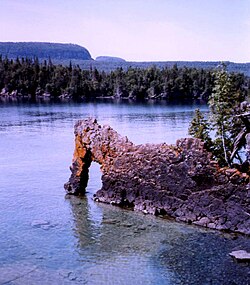Unorganized Thunder Bay District
Unorganized area in Ontario, Canada From Wikipedia, the free encyclopedia
Unorganized area in Ontario, Canada From Wikipedia, the free encyclopedia
Unorganized Thunder Bay District is an unorganized area in northwestern Ontario, Canada in Thunder Bay District. It comprises all parts of the district that are not part of an incorporated municipality or a First Nations reserve.
Unorganized Thunder Bay | |
|---|---|
| Thunder Bay, Unorganized | |
 Sleeping Giant Provincial Park | |
 | |
| Coordinates: 50°00′N 88°00′W | |
| Country | Canada |
| Province | Ontario |
| District | Thunder Bay |
| Government | |
| • Federal riding | Algoma—Manitoulin—Kapuskasing Kenora Thunder Bay—Rainy River Thunder Bay—Superior North |
| • Prov. riding | Algoma—Manitoulin Kenora—Rainy River Thunder Bay—Atikokan Thunder Bay—Superior North |
| Area | |
| • Land | 97,009.80 km2 (37,455.69 sq mi) |
| Population (2016)[1] | |
| • Total | 5,872 |
| • Density | 0.1/km2 (0.3/sq mi) |
| Time zones | |
| East of 90° west | UTC-05:00 (Eastern) |
| • Summer (DST) | UTC-04:00 (EDT) |
| West of 90° west | UTC-06:00 (Central) |
| • Summer (DST) | UTC-05:00 (CDT) |
| Postal Code FSA | P0T |
| Area code | 807 |
Most of the territory is within the Eastern Time Zone, but the part west of the 90th meridian is in the Central Time Zone.
Gold was noted in the area since 1869, but it wasn't until Peter Moses from Heron Bay, Ontario discovered additional gold that prospectors flocked to the area. In 1947, Dr. J. Williams and Moses staked 11 claims, which became the Lake Superior Mining Corporation. However, not much development took place until 1979, when Don and David McKinnon, along with John Larche, staked claims in Hemlo and the Manitouwadge area. The Williams Mine started operation in 1985, and produced 445,320 ounces of gold from a 2.45 meter wide ore body. The Golden Giant Mine produced 446,858 ounces in 1994 from a quartz sericite schist host rock. The David Bell Mines produced 204,251 ounces in 1994. The Hemlo gold mines had produced more than 6,000,000 ounces of gold by 1992.[2]
| 2016 | 2011 | |
|---|---|---|
| Population | 5872 (-0.6% from 2011) | 5909 (-10.3% from 2006) |
| Land area | 97,009.80 km2 (37,455.69 sq mi) | 97,007.34 km2 (37,454.74 sq mi) |
| Population density | 0.1/km2 (0.26/sq mi) | 0.1/km2 (0.26/sq mi) |
| Median age | 51.4 (M: 52.0, F: 50.9) | |
| Private dwellings | 6130 (total) | 5782 (total) |
| Median household income | $70,886 |
Population trend:[7]
Provincial parks in Unorganized Thunder Bay include:
It is also home to one National Park of Canada: Pukaskwa National Park.
Via Rail's The Canadian serves the Unorganized Thunder District at the communities of Flindt Landing,[8] Mud River,[9] Ferland,[10] and Auden.[11]
| Current services at Flindt Landing station | ||||
|---|---|---|---|---|
| Preceding station | Following station | |||
| Savant Lake toward Vancouver |
The Canadian | Allanwater Bridge toward Toronto | ||
| Preceding station | Following station | |||
| Current services at Mud River station | ||||
| Armstrong toward Vancouver |
The Canadian | Ferland toward Toronto | ||
| Former services at Mud River station | ||||
| Preceding station | Canadian National Railway | Following station | ||
| Willet toward Vancouver |
Main Line | Ferland toward Montreal | ||
| Current services at Ferland station | ||||
| Preceding station | Following station | |||
| Mud River toward Vancouver |
The Canadian | Auden toward Toronto | ||
| Former services at Ferland station | ||||
| Preceding station | Canadian National Railway | Following station | ||
| Mud River toward Vancouver |
Main Line | Jackfish River toward Montreal | ||
| Preceding station | Following station | |||
| Current services at Auden station | ||||
| Ferland toward Vancouver |
The Canadian | Nakina toward Toronto | ||
Seamless Wikipedia browsing. On steroids.
Every time you click a link to Wikipedia, Wiktionary or Wikiquote in your browser's search results, it will show the modern Wikiwand interface.
Wikiwand extension is a five stars, simple, with minimum permission required to keep your browsing private, safe and transparent.